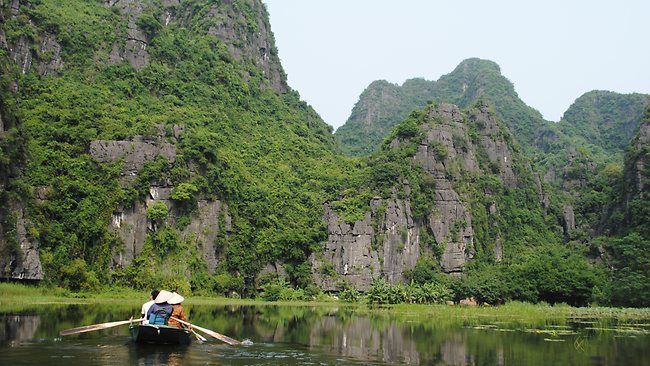
Locals travel the waterways near Tam Coc. Source: National Features
I\'m feeling guilty. I\'m relaxing on the flat-bottomed boat while a woman rows through water-lilies.
What\'s more, she seems old enough to be my mother (well, at least my much older sister).
But my guilt ebbs as I learn that my boatwoman with the brown, weathered face is a relatively sprightly 51 and I\'m the first tourist here at the magnificent Van Long Nature Reserve for five days. It\'s the low season and this is a poor area, with any tourism enticed by the wealth of wondrous waterways and pinnacle-like mountains boosting meagre incomes.
"The men in this region are very lazy," my guide, Tim from Hanoi, confides as we glide across shallow lagoons below lofty limestone outcrops and peaks. "They sit around in the shade and play cards and make the women do all of the work."
I feel guilty again.
The French dubbed this underrated part of north central Vietnam the "Halong Bay on dry land", a reference to the World Heritage-listed, watery, karst-studded wonderland on the South China Sea north of Hanoi.
Just like Halong Bay, a visit to this provincial region known as Ninh Binh, an easy few hours\' drive south of the capital Hanoi, is more rewarding if you stay overnight, rather than make the usual day trip.
Ninh Binh, I discover, is the fall-back destination for tour groups when the weather in Halong Bay is unsuitable for cruising. But Ninh Binh more than adequately matches its more famous counterpart in the scenery stakes, especially since it\'s far easier here to connect with the ordinary Vietnamese.
Back at the boat a large dragonfly skids across the lime-green water beside us, bouncing across a surface undisturbed by few other boats. In the distance is a Catholic church with a stone steeple and a red roof, one of the many Christian places of worship that I will encounter on this short visit. This languid boat ride at Van Long costs at just $US3, plus a generous tip, especially when I learn the boatwoman has a disabled daughter.
This two-day sojourn from Hanoi is all about water and worship. Although this region is rightly renowned for those strangely alluring rocky outcrops that protrude dramatically from ricefields beside stunning waterways, a quarter of the population in this region a legacy of French colonial rule and the influence of Christian missionaries are Catholic. But Buddhism asserts itself here, too, at the ruins and temples of the ancient former Vietnamese capital of Hoa Lu, dating to AD968, and once the site of a vast palace and citadel.
Later in the afternoon, when we are thankful for a tempering of the northern Vietnam summer heat, our next stop is the village Kenh Ga for a motorised boat ride on the Hoang Long River. On the water we pass white storks balanced on water-lilies, as well as partly submerged Catholic tombs, their tell-tale crosses poking just above the water.
At Kenh Ga (which means Chicken Canal) the village is built on a narrow island complete with a 50-year-old mustard-coloured church that has water lapping at its front steps, with some houses inundated by the summer rains. The locals get around town by rowboat, often containing bicycles for visits to the mainland.
On the motorboat we putter along the river at a suitably leisurely pace with activity all around us: a funeral procession of vessels, with mourners dressed in traditional all-white, passes in the distance; a woman in gumboots on a narrow sandbank is walking to a bamboo lean-to shelter; mountain goats teeter on steep slopes while a female caretaker with a moored sampan tends to a statue of Jesus in the arms of Mary on a tiny, rocky island.
On the shore, through the chalky afternoon haze, there\'s yet another substantial cathedral that looks to be a few hundred years old, but which turns out to be only recently built, an indication that the faith of the Vietnamese Catholics remains strong.
The next day, after a stay in unremarkable though centrally located Ninh Binh, we head to the more commercialised waterways of Tam Coc, which means three caves, the most visited attraction in the region. Here, for $US5, you can travel leisurely along the river and through lagoons, passing through caves as long as 60m, inside which the fighting Viet Cong used to store weapons during the war against the occupying French in the 1950s.
Nearly all of the boats I see are rowed by women, rather nonchalantly, using their feet. Due to the recent wet season, the water level is so high that I have to duck into the rowboat when we pass under bridges or enter the caves.
Back in the harsh light of day, chooks crow in the distance and cows graze on the verdant banks against a backdrop of free-standing outcrops. At the end of the cruise back at Dinh Cac Pier, my guide and I are besieged by hawkers (though it\'s said to be much worse in the high season) and escape into our waiting car to be whisked to our next stop.
Before heading back to Hanoi there\'s one last location on our itinerary, Phat Diem, the home of an unusual Catholic cathedral built in a Sino-Vietnamese architectural style. At first it resembles a Buddhist temple until you sight the crosses atop the roof and an imposing snow-white statue of Jesus with outstretched arms out front.
It\'s said that the colossal single bell of the cathedral completed in 1898 is so loud when rung that it can be heard across the province. Inside the cathedral is a massive vaulted timber ceiling supported by 52 rough-hewn ironwood tree columns.

Leave your comment on this story